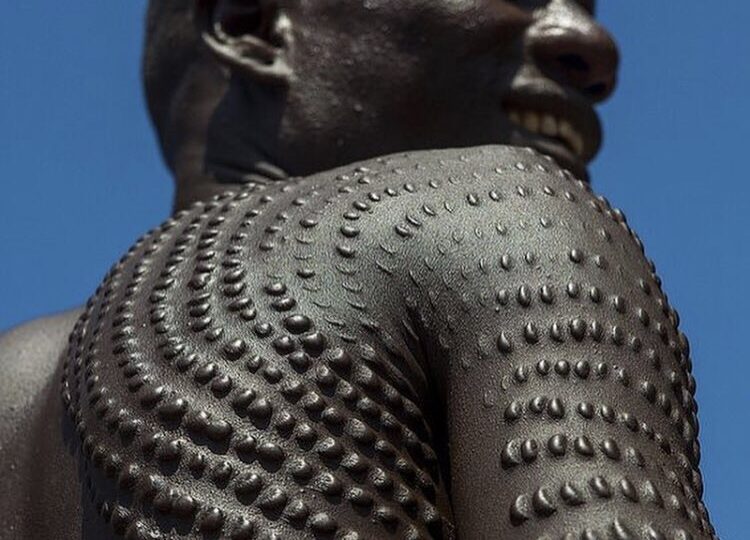The jet-black, onyx skin of South Sudanese people has long been a striking feature of African diversity, and in ancient times, it found a place in the art of the Nile Valley. From Nubia to ancient Kemet (Egypt), South Sudanese phenotypes were celebrated in wall paintings, sculptures, and reliefs, reflecting the region’s embrace of all skin tones.
The Know Thyself Institute highlights how these depictions weren’t just artistic—they were a testament to the Nile Valley’s cultural unity, where diverse peoples came together to create a civilization that still awe us (Know Thyself Institute, 2025). Imagine a time when onyx-black skin was immortalized alongside reddish-brown and high yellow tones, with no hierarchy of worth.
This article explores how South Sudanese phenotypes were represented in Nile Valley art, the cultural significance of this inclusion, and what it means for modern African identity. Let’s uncover the beauty of onyx skin in ancient art, a reminder of Africa’s timeless celebration of diversity.
South Sudanese Phenotypes in the Nile Valley
The South Sudanese, particularly the Dinka and Nuer peoples, are known for their deep, onyx-black skin, a trait that has been part of their identity for millennia. While South Sudan is geographically distant from the Nile Valley, ancient trade and migration routes connected these regions as early as 2500 BCE.
The Nile River, stretching from its southern tributaries to Egypt, acted as a corridor for cultural exchange, bringing South Sudanese peoples into contact with Nubia and Kemet.
Archaeological evidence supports this connection. Pottery fragments found in South Sudan, dating to 2000 BCE, share stylistic similarities with Nubian ceramics, suggesting trade or migration (Institute for the Study of Ancient Cultures, 2025).
The South Sudanese, often depicted with their onyx-black skin in Egyptian art, were likely part of these networks. For example, the tomb of Huy, a governor under Tutankhamun, includes a scene of “People of Punt” bringing tribute—some scholars believe these figures, with their dark complexions, may represent South Sudanese or related groups (Kemet Expert, 2025).
This presence wasn’t just incidental. The South Sudanese’s onyx skin became a symbol of the Nile Valley’s diversity. In Nubia, which had closer ties to South Sudan, the Meroitic period (300 BCE–350 CE) saw an increase in depictions of darker-skinned figures in art, reflecting the region’s cultural blend. The Nile Valley wasn’t a homogenous society—it was a melting pot where South Sudanese phenotypes stood alongside Nubian, Egyptian, and Horn African traits, creating a rich tapestry of humanity.
Depictions of Onyx Skin in Nile Valley Art
In Nile Valley art, the onyx-black skin of South Sudanese peoples was celebrated with reverence. Wall paintings in the tomb of Rekhmire, a vizier under Thutmose III, show dark-skinned figures alongside lighter-skinned Egyptians, all depicted with equal dignity (Nile Valley Collective, 2025).
These scenes aren’t about hierarchy—they’re about unity, showing how the Nile Valley embraced its diverse peoples. The jet-black tones, often achieved with charcoal-based pigments, were a deliberate choice, highlighting the beauty of this phenotype.
Sculptures also reflect this celebration. The statues of Nubian pharaohs like Taharqa, who ruled Egypt during the 25th Dynasty, emphasize their onyx-black skin with polished black granite, a material chosen to mirror their complexion (Kemet Expert, 2025).
This wasn’t just symbolism—it was a statement of pride, showing that darker skin was a mark of royalty, not inferiority. Even in mythology, deities like Osiris were often depicted with dark skin, linking blackness to divinity and renewal.
The cultural significance of these depictions goes beyond aesthetics. By including South Sudanese phenotypes, Nile Valley artists were acknowledging the region’s role as a cultural crossroads.
The onyx-black skin of these figures stood alongside the reddish-brown of Upper Egyptians and the high yellow of Horn Africans, creating a visual narrative of unity. This art wasn’t about exclusion—it was about inclusion, a reflection of the Nile Valley’s interconnectedness with the broader African continent.
This celebration of diversity challenges modern biases. In a world where colorism often favors lighter skin, the Nile Valley’s art shows us what’s possible when all phenotypes are valued. The onyx-black skin of South Sudanese peoples wasn’t just seen—it was honored, a testament to the region’s inclusive values.
Modern Appreciation of African Diversity
The depiction of South Sudanese onyx skin in Nile Valley art offers a powerful lesson for today. In many modern African and diasporic communities, colorism remains a challenge, with darker skin often stigmatized.
But the Nile Valley shows us a different way—a society where onyx-black skin was celebrated as a mark of beauty and strength.
This history can also foster pride in African identity. For South Sudanese people, seeing their ancestors’ traits celebrated in ancient art is a source of empowerment, a reminder that their onyx skin has always been a part of Africa’s greatness. For the broader diaspora, it’s a call to celebrate diversity, recognizing that Africa’s strength lies in its variety of peoples.
Moreover, this history challenges Eurocentric narratives that whitewash ancient Egypt. By highlighting the presence of South Sudanese phenotypes, we can root Egypt in its African context, a perspective championed by the Nile Valley Collective (Nile Valley Collective, 2025).
Imagine if museums and schools taught this inclusive history, showing how the Nile Valley celebrated all shades. It could transform how we see ourselves and each other, building a world where diversity is a source of unity, not division.
The onyx-black skin of South Sudanese peoples in Nile Valley art is a beautiful reminder of Africa’s diversity and unity. From wall paintings to sculptures, ancient Kemet celebrated all phenotypes, showing us what’s possible when we value everyone equally.
Today, this history challenges us to combat colorism and embrace our shared heritage, whether we’re in Juba or the diaspora. Let’s honor the South Sudanese legacy by celebrating all shades, building a future where diversity is our strength.
Want to learn more about this incredible story? For a scholarly perspective, explore this Afriker.com. Together, we can keep the beauty of onyx skin in African history alive, shining as brightly as it did millennia ago.

